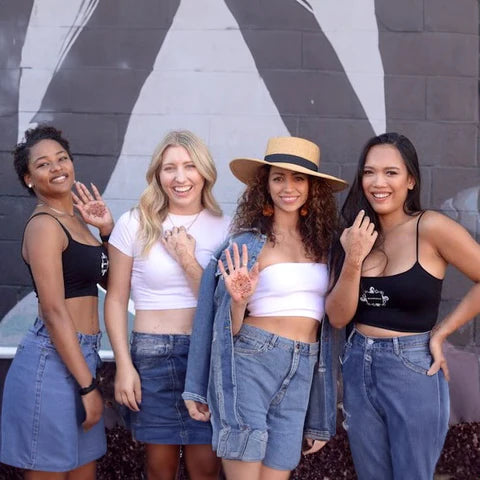While we can’t speak for everyone from the various cultures where henna originated, as an Indian-owned business, we feel that the art of henna is part of cultural sharing and helps to make our world a more united and beautiful place. We are proud to share a piece of our culture that empowers women and brings us all together in celebration and love.
Skip Ahead
What is Cultural Appropriation?
Cultural appropriation has become nearly synonymous with cultural misappropriation or even cultural theft. The most general description of cultural appropriation is when members of a dominant, or more powerful, culture adopt elements from a disadvantaged minority culture.
Other factors can make the act of appropriation even more detrimental to the minority culture:
- When the appropriated element is one for which the minority culture has faced discrimination
- When the dominating culture has paid extraordinarily few reparations or none at all
- When the element is part of religion, ceremony, or private rituals
The dominating culture does more social and even emotional damage by appropriating elements that fall into these categories.
We don’t have to look far to find examples of cultural appropriation; it has occurred throughout history and continues today. Specifically for Indians, we’ve seen many forms of appropriation by more powerful cultures. From the most extreme desecration to the subtlest theft, Indians are just one of many disempowered minorities to face appropriation.
Example 1: The Swastika
For 5,000 years, a variety of religions in India have revered the swastika as a message of divinity, peace, and good fortune. In fact, the symbol spread around the world as a sign of peace. Even boy and girl scouts in America had swastika badges. India was more than happy to share when the icon was represented correctly. After the Nazis appropriated the symbol to represent their party of hate and dominion, the swastika has never recovered from the stigma in Western cultures. This manipulation of a religious icon has lead to near-fatal misinterpretations for Indians traveling or living around the world.
Example 2: Turban Fashion
Even less severe manipulation can have more impact than the appropriating culture realizes. In 2018, Gucci's models wore Sikh-style turbans during their runway walk at Milan Fashion Week. While it may seem innocent enough, Gucci did not include any actual Sikh representation among their models, did not confront the misplaced Islamophobia and discrimination that Sikhs face for their turbans, and did not take into account the religious and identity elements of the Sikh turban. They showed off a watered-down version of the turban that had been stripped of its history and importance. Additionally, their $790 pre-wrapped turban sales in no way give back to the minority community from whom they appropriated their runway look. Read more on CNN.
The idea can be summed up nicely by a quote from Tenisha F. Sweet:
"If you don't understand cultural appropriation, imagine working on a project and getting an F. Then somebody copies you and gets an A and takes credit for your work."
Cultural appropriation is about taking. There are ways to participate in culture, like the art of henna, without cultural appropriation. At Mihenna, we focus on sharing.
What is Cultural Sharing?
Cultural sharing, also called cultural exchange, is an act of mutually beneficial sharing of cultural elements and beliefs. Because we live in a society where different cultures frequently come into contact with each other, cultural sharing is an inevitable part of our lives. It’s also an important aspect of creating a diverse and compassionate community.
Some of the most common cultural sharing happens through art and music. Both are ways to express our human nature, innermost feelings, and common experiences. It’s not uncommon to connect with a painting or song from outside your culture because it speaks to some feeling you’ve had or an event you’ve also been through. Self-expression is a natural way for humans to connect over the emotions and experiences shared throughout a lifetime.
Strife between cultures can sometimes be based on simply ~fear of the unknown.~ Human connection allows us to combat this fear and reach an understanding that our cultures are not so different. This human connection is facilitated by cultural sharing. As we learn about each other’s cultures, we create a more accepting and diverse society that offers us more opportunities to learn and grow. We create a more empathetic and caring humanity that benefits future generations.
Cultural sharing also uniquely benefits the originating culture (which would have been known as the disadvantaged culture if this was an example of cultural appropriation). When cultural elements are shared with the consent of the originating culture - instead of being stolen, taken by force, or misappropriated - they will receive social and also financial benefits.
- Socially, these shared cultural elements become more accepted as they become more public. We might consider something strange if we had seen it only once or twice, but as we are more exposed, we grow more familiar and less concerned or surprised.
- Financially, the originating culture also benefits when we buy directly from them instead of from some corporation that has committed an appropriation. By financially supporting the originating culture, we give them the freedom to continue to create and explore new ideas.
All these things rely on you knowing what is appropriation and what is shared.
Doing Our Part
There are two important ways to make sure we are participating in cultural sharing and not misappropriation. Although it may seem like work at first, the more we integrate these concepts with our purchasing choices, the more we will grow as knowledgeable consumers and partakers in culture, the more we will uplift the originating culture.
- Learn more about the cultural element you are engaging with. Take the time to find out if the cultural element is sacred, religious, ceremonial, or must be earned. Understand the history of whether the originating culture has faced discrimination or unfair practices because of this part of their culture. Find out if this is something they are willing to share across cultures. We suggest reading about the history of henna to understand more of how this art form grew into the worldwide phenomenon it is today.
- Research to ensure that when you purchase some element of a culture, you are financially supporting the originators and not the appropriators. Look into the business to see who owns it and where they obtain the product. Your buying power has a lot of influence over whether corporations are profiting from appropriation.
Conclusion

We started Mihenna because we wanted to share an important element of our culture with more people around the world. Henna is an art form that allows for self-expression, makes you look beautiful and feel empowered. We want everyone to have that experience when they use our products. We strive to make henna tattoos more accessible to everyone as part of our cultural sharing.
